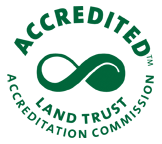We have all heard the classic stories of alien invasions coming to Earth. But did you know that the invasion is happening right now? It’s not an invasion of flying saucers, but rather small plants and creatures that may seem to be plain ordinary members of an ecosystem. These deceptive beasts are none other than: Invasive Species.
Common Invasive Species in New York
So, what’s the scoop? What are they and why are they bad?
An invasive species is defined as a species that is not native to an environment and causes harm to either the environment, the economy, or humans. Invasive species are different from “exotic” species, which are species that come from a different region, but do not cause harm. Invasive species can destroy crops, kill native forest trees, spread disease among native plants and animals, and dominate ecosystems by outcompeting native species. New York is vulnerable to invasive species invasion because it is a big hub for trade.
Invasive species can be plants, bacteria, insects, or other animals - anything that does not come from the ecosystem it is residing in. Some species were brought by mistake by mistake, often hitching a ride on cargo or being dumped in ballast waters from ships, while others are from ornamental plants that grew out of control. Read up about some of the common invasive species that can be found in New York:
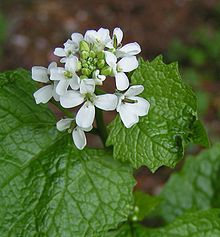 Garlic Mustard: Alliaria petiolata
Garlic Mustard: Alliaria petiolata
Identification: First year growth is small hoof-shaped leaves with rounded edges; second year is flowering with flower spikes; and alternate leaves on stems varying from rounded to pointed with teeth.
Where it’s found: Will grow in many landscapes and ecosystems; common on roadsides and along paths.
What it does: Produces chemicals to prevent other species growth and changes structure of forest floor plants.
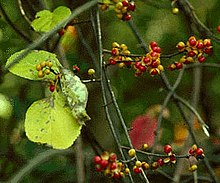 Oriental Bittersweet: Celastrus orbiculatus
Oriental Bittersweet: Celastrus orbiculatus
Identification: Thick vine that grows around and girdles trees; young light green tendrils; alternating leaves ranging in shape from tear drop to large rounded; and red berries with yellow husks visible in winter.
Where it’s found: Will grow in many landscapes. Found on edge territory; will climb trees, fences, and other structures.
What it does: Crowds out native species; shades out trees; and girdles plants that it grows over.
 Japanese Barberry: Berberis thunbergia
Japanese Barberry: Berberis thunbergia
Identification: Long oval leaves clustered on stems; many thorns; inner wood can be bright yellow; bush coloration green or dark red; small red bean shaped berries; and growth can be small bushes or long branches.
Where it’s found: Will grow in disturbed sites and in forests as random patches; popular ornamental.
What it does: Crowds out native species; changes soil ph and temperature; and harbors tick nests.

Purple Loosestrife: Lythrum salicaria
Identification: Tall growth with opposite and whorled leaves with perimeter vein; tall purple flower spike; and square stem.
Where it’s found: Found along roadways, water, and stream banks.
What it does: Produces dense growth making waterway access difficult; outcompetes native plants with dense roots that alter hydrology.
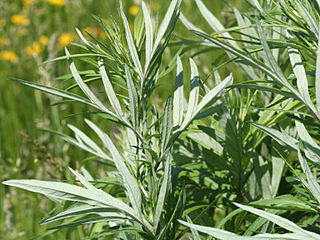 Mugwort: Artemisia vulgaris
Mugwort: Artemisia vulgaris
Identification: Alternating many pointed lobed leaves, vary in shape but all multi-frond like; smooth green stem with small leafy protrusions.
Where it’s found: Popular ornamental for medicinal properties; found in edge habitats, roadways, along water, and waste areas.
What it does: Crowds out native species; contaminates nursery stock through rhizomes; and disrupts natural succession in ecosystems.
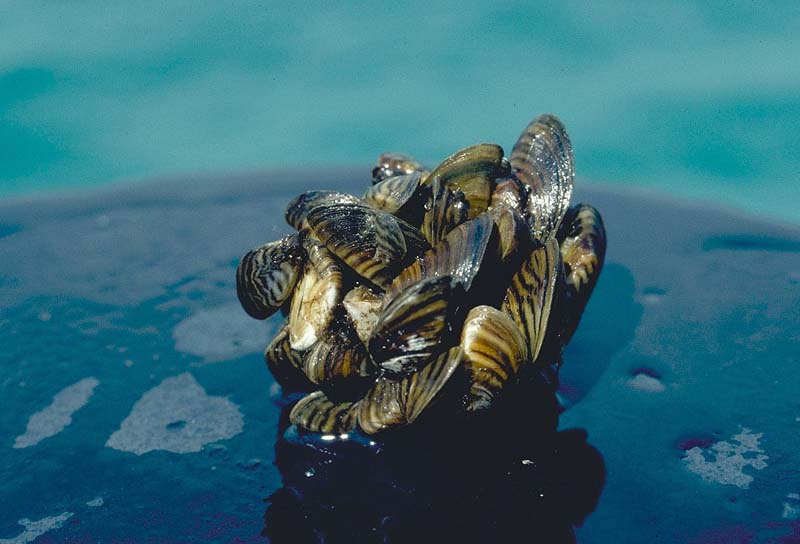 Zebra Mussels: Dreissena polymorpha
Zebra Mussels: Dreissena polymorpha
Identification: Small mussel with brown and tan zigzag stripes and jagged edges; often found in clusters.
Where it’s found: Found in rivers and lakes; dropped out of ballast waters and can secure to boat hulls.
What it does: Crowds out native species; over filters water; causes growth of algae blooms.
Did you Knows:
A species can be invasive but come from the same country. The red eared slider’s native range is in the Midwestern United States but is invasive to New York and the east.
Some large problem species are from the pet trade. People will buy exotic animals, but when they become too difficult to take care of, they will release them into the wild. While this may seem like the ethical choice (rather than have the animal be put down), the species could cause huge problems by becoming a predator or consuming all the food in the ecosystem. Examples of this are the Goldfish and the Burmese Python.
Species can be introduced without becoming invasive. An introduced species will be classified as invasive if it becomes detrimental to the ecosystem or people. Species can also become invasive if an ecosystem changes. With climate change, we may see some species become invasive that weren’t otherwise.
How to Manage the Invasions
When an invasive species is first introduced to a new ecosystem, there is a small window of time where the species can be successfully eradicated before it becomes established. Unfortunately, the way most invasive species are discovered by scientists identifying the problem they are causing, which means they are already established and spreading. When eradication is no longer possible, the focus shifts to management.
There are a few ways to manage invasive species:
Physical removal: physical plant management includes hand pulling, cutting, digging out root balls, and in some cases, burning. Cuttings have to be thrown away in sealed bags in the landfill. For animals, removal is mainly trapping; however this has limited efficiency, so most focus is dedicated to preventing further spread
Chemical removal: chemical removal involves pesticide, insecticide, and herbicides for both plants and animals. Chemical removal has to be done cautiously because there is the potential for chemicals to contaminate soils and water and to harm native or non-target species.
Biocontrol: one management technique that is more challenging is biological control or biocontrol. Biocontrol utilizes the natural predators of the problem invasive species. This often takes several years to establish because there has to be extensive research on the predator so the potential control doesn’t become an invasive species itself. Biocontrol species are often specialist species, which means they only feed on one type of prey.
The best way to stop invasive species is through prevention. Here are some simple steps that can make a big difference!
- Follow the trail: Staying on marked trails does more than keep you safe - going off trail can cause fragments of invasive plants to get picked up and carried to another location, or you could be bringing invasive plant material from your yard or garden.
- Wash Your Clothes: after a hike, it is common to have some mud and dirt on your clothes. There may be hidden species in the mud and dirt. If your clothes are still clean, you can put them in a hot dryer cycle.
- Scrape those boots: Boots are quite easy ways for invasive species to be carried because of their thick treads with crevices. Carry a small boot brush with you to clean your boots before and after entering a wild area. An incredibly good boot brush is a horse hoof pick. Some trails will even have special boot brush stations at the trail head.
- Clean fishing gear: Clean fishing gear and boats: clean any plant fragments from your fishing gear, clothes, and the outside of your boat, especially when moving from one waterbody to another. Throw out unused bait in the garbage.
- Buy native plants: exotic plants are often beautiful additions to gardens, but they are also responsible for invasive species spread. Fortunately, there are lots of colorful native plants that are available for garden use. If you want plants that are exotic, check to see if they are invasive; alternatively, keep exotic plants in pots in your house.
- Be careful when you dispose of plants: Composting is a great way of keeping plant and food scraps out of the landfill and add nutrient back to gardens and soil. With exotic or invasive species, the process is a little different - composting would allow seeds to stay viable and some plants can grow from broken fragments. Take any plant fragments and throw them away in sealed bags.
- Spread the word: tell others about invasive species and how they can stop invasive species spread. Help everyone join in the fight against invasive species!


